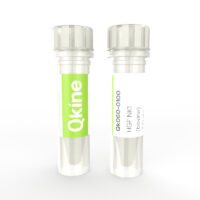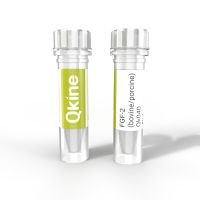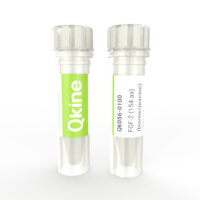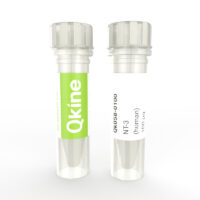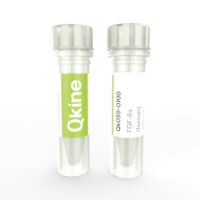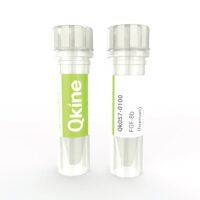- Recombinant bovine HGF protein is a potent, high-purity NK1 isoform of bovine hepatocyte growth factor (HGF). Bovine HGF differs from human HGF at several key amino acid residues that are predicted to affect bioactivity and receptor binding. Use of species-specific HGF growth factor will facilitate media optimization for cellular agriculture (cultivated meat) and veterinary applications. Also available is Qk061 Porcine HGF (NK1). The highly scalable animal-free manufacture and enhanced bioactivity make this suitable for chemically-defined media and reproducible scale-up.20kDa naturally occurring isoform of HGF, animal-free and carrier-protein free.
- Recombinant bovine/porcine FGF2 protein 145 aa (bFGF/basic FGF) for the development of species-specific bovine (cow) and porcine (pig) cellular agriculture protocols and veterinary research applications. Used in comparative cell culture media optimization studies alongside Qk056, the 154aa form of porcine/bovine FGF-2.FGF-2 is used extensively in the maintenance and proliferation of induced pluripotent (iPSC) and embryonic stem cells (ESC)1-3 and for enhancement of proliferation in primary cell culture.High purity 16 kDa FGF-2 / bFGF protein, animal origin-free (AOF) and carrier-protein free (CF).
- Recombinant bovine/porcine FGF2 protein 154 aa (bFGF/basic FGF), this is the long form of FGF-2 used for the development of optimized serum-free culture media for species-specific bovine (cow) and porcine (pig) cultivated meat and veterinary research applications. Used in comparative media optimization studies with Qk040 porcine/bovine FGF-2 145 aa.FGF-2 is used extensively in the maintenance and proliferation of induced pluripotent (iPSC) and embryonic stem cells (ESC)1-3 and for enhancement of proliferation in primary cell culture.High purity 16 kDa FGF-2 / bFGF 154 aa protein, animal origin free (AOF) and carrier-protein free (CF).
- Neurotrophin 3 protein is part of the neurotrophin family and plays a crucial role in embryonic development and the maintenance and neuroprotection of the adult nervous system.NT-3 protein is used in cell culture to promote the differentiation and survival of specific neural subpopulations in both the central nervous system and peripheral nervous system such as sensory neurons, cortical neurons, and oligodendrocytes. It is also involved in the maintenance of endothelial cells and myocardial cells.Recombinant Neurotrophin 3 protein is a non-covalently linked homodimer with a molecular weight of 27.3 kDa.Qkine NT3 protein is animal-free (AOF), carrier-free, tag-free, and non-glycosylated to ensure its purity with exceptional lot-to-lot consistency. It is suitable for the culture of reproducible and high-quality cortical neurons and oligodendrocytes.
- Fibroblast growth factor 8a (FGF-8a) is a member of the FGF family and plays a key role in the regulation of embryogenesis, cellular proliferation, differentiation, and migration. FGF8a is often used for the differentiation of induced pluripotent stem cells, embryonic stem cells, and neural stem cells.FGF8a is a spliced form of FGF8, a heparin-binding protein that targets mammary and non-mammary cells expressing the FGF receptors. A 21.3kDa highly pure, bioactive recombinant protein produced in an animal-free expression system. This protein is animal-origin free (AOF), carrier protein-free, tag-free, and non-glycosylated to ensure a pure homogenous protein with exceptional lot-to-lot consistency. Qk059 is suitable for enhanced reproducibility and physiologically relevant cultures.
- Fibroblast growth factor 8b (FGF-8b) is a member of the FGF family involved in the regulation of embryogenesis, cellular proliferation, differentiation, and migration.FGF8b is commonly used for the differentiation of induced pluripotent stem cells into neural cell types and brain organoid cultures.FGF8b is a spliced form of FGF8, a heparin-binding protein that targets mammary and non-mammary cells expressing the FGF receptors. A 22.5 kDa highly pure, bioactive recombinant protein produced in an animal-free expression system. This protein is carrier-free, tag-free and non-glycosylated to ensure a pure, homogenous protein with exceptional lot-to-lot consistency. Qk057 is suitable for enhanced reproducibility and physiologically relevant cultures.
